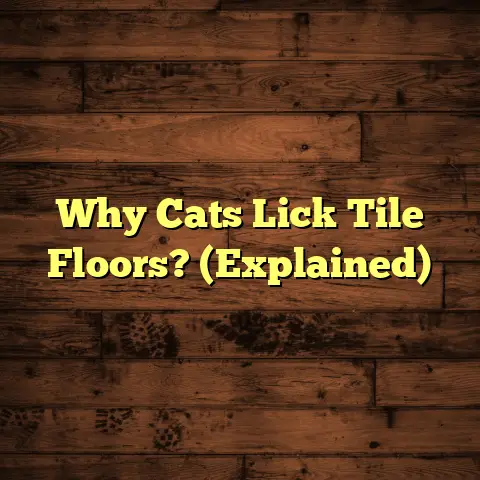Remove Floors In Dwarf Fortress? (3 Min Read!)
Have you ever found yourself trapped in a maze of floors in Dwarf Fortress, unable to find a way to remove them without causing chaos in your fortress? I know I have! It’s a common problem for both new and experienced players alike. Let’s dive into how you can efficiently remove floors and reclaim your fortress’s layout.
Section 1: Understanding Dwarf Fortress Mechanics
Dwarf Fortress, at its heart, is a game of systems. Understanding how these systems interact, especially the building and construction elements, is key to mastering the game. Think of it like this: every action has a reaction, and knowing what that reaction will be can save you a lot of headaches (and dead dwarves!).
Flooring in Dwarf Fortress isn’t just for aesthetics, although a well-tiled dining room does boost morale. It affects dwarf movement speed, room designation, and even the structural integrity of your fortress. A smooth, paved floor is faster to walk on than rough, uneven ground, which is why you’ll often see dwarves prioritizing paving high-traffic areas.
Flooring also plays a crucial role in defining rooms. A room needs to be fully enclosed by walls and a floor to be recognized as a designated space, like a bedroom or a dining hall. This, in turn, affects dwarf happiness and efficiency. Believe me, a happy dwarf is a productive dwarf!
Finally, flooring interacts with other components like support structures and mining. A floor can act as a support, preventing cave-ins, while mining operations can be significantly impacted by the presence (or absence) of flooring above or below. It’s all interconnected, like a giant, pixelated Rube Goldberg machine.
Section 2: The Importance of Removing Floors
So, why bother removing floors in the first place? Well, there are several scenarios where it becomes necessary, or even strategically advantageous.
Expanding Your Fortress
One of the most common reasons is expansion. You might want to carve out a new section of your fortress, but an existing floor is in the way. Maybe you’ve found a vein of valuable ore beneath a paved corridor. Or perhaps, you simply want to redesign a room.
Creating Traps or Defensive Structures
Removing floors can be a key component in creating traps or defensive structures. A strategically placed pitfall trap, for example, requires removing the floor beneath the unsuspecting goblins’ feet. A collapsing corridor can also be a nasty surprise for invaders.
Correcting Construction Mistakes
Let’s face it, we all make mistakes. I know I’ve accidentally built a floor where I meant to build a wall more times than I care to admit. Removing floors allows you to correct these errors and refine your fortress layout.
Facilitating Mining Operations Below the Floor
Sometimes, the richest veins of ore are located deep beneath existing floors. Removing the floor allows your dwarves to access these resources without having to detour around them.
Implications of Floor Removal
Removing floors can have significant implications on dwarf behavior, pathfinding, and fortress stability. Dwarves will avoid walking over open pits, so removing a floor can effectively block off a corridor. This can be useful for controlling traffic flow or creating choke points in your defenses.
However, removing floors can also disrupt pathfinding, leading to dwarves getting lost or taking longer routes to their destinations. And, of course, removing floors that are acting as supports can lead to cave-ins, which can be catastrophic for your fortress.
Section 3: Tools and Techniques for Floor Removal
Okay, so you’ve decided you need to remove some floors. How do you actually do it? Fortunately, Dwarf Fortress provides a straightforward method, although it can be a bit finicky at times.
Using the ‘Remove Construction’ Command
The primary tool for removing floors is the ‘Remove Construction’ command. You can access this command by:
- Pressing d to enter the designations menu.
- Pressing n to select ‘Remove Construction’.
- Using the arrow keys or the mouse to select the area you want to remove.
- Pressing Enter to confirm your selection.
Your dwarves will then begin the process of deconstructing the designated floors. Keep in mind that this process requires dwarves with the appropriate labor enabled (usually ‘Construction’ or ‘Mining’).
It’s also worth noting that the ‘Remove Construction’ command can be used on a variety of other building elements, such as walls, doors, and furniture. It’s a versatile tool that you’ll be using constantly throughout your game.
The Role of Different Materials
The material of the floor can sometimes affect the speed at which it is removed. For example, a floor made of easily mined stone like sandstone will be removed faster than a floor made of obsidian. However, the primary factor affecting removal speed is the skill of the dwarf performing the task.
Some materials might require specific tools or methods for removal. For instance, if you’ve accidentally built a floor out of ice, you might need to melt it before your dwarves can remove it. (Pro tip: channel some magma nearby!).
The Impact of Designations on Dwarf Labor
Efficiently managing labor assignments is crucial for ensuring that floor removal is carried out quickly and without disrupting other tasks. Make sure that you have enough dwarves with the ‘Construction’ or ‘Mining’ labor enabled and that they are not already occupied with other urgent tasks.
You can prioritize floor removal by using the ‘Job Management’ screen (accessible by pressing j). This allows you to reorder tasks based on their importance, ensuring that your dwarves focus on removing floors before tackling other projects.
Section 4: Advanced Techniques and Tips
Once you’ve mastered the basics of floor removal, you can start exploring some advanced techniques that can significantly speed up the process and allow you to tackle larger-scale projects.
Utilizing Cave-ins for Large-Scale Floor Removal
Cave-ins can be a powerful tool for removing large areas of flooring quickly. However, they are also incredibly dangerous and should only be attempted by experienced players who understand the mechanics involved.
The basic principle behind a cave-in is to remove support structures, causing the ceiling above to collapse. This can be achieved by:
- Identifying a section of floor that you want to remove.
- Mining out the support structures beneath that section. This could be walls, columns, or even other floors.
- Once the supports are removed, the floor will collapse, creating a large open space.
Warning: Cave-ins can be extremely destructive and can easily kill dwarves if they are caught in the collapse. Always plan your cave-ins carefully and ensure that all dwarves are clear of the area before removing the supports.
I once tried to remove a large section of floor using a cave-in, only to accidentally collapse half of my fortress! It was a disaster, but I learned a valuable lesson about the importance of careful planning.
The Use of Designations to Manage Dwarf Traffic
During floor removal, it’s important to manage dwarf traffic to avoid accidents and ensure that the work is carried out efficiently. You can use designations to control where dwarves are allowed to walk.
For example, you can use the ‘Traffic Designation’ tool (accessible by pressing d and then t) to restrict dwarf movement in areas where floors are being removed. This can prevent dwarves from accidentally falling into open pits or getting caught in cave-ins.
Managing the Aftermath of Floor Removal
Floor removal often leaves behind debris, such as rubble and loose stones. It’s important to manage this debris to prevent it from cluttering your fortress and slowing down dwarf movement.
You can use the ‘Hauling’ labor to assign dwarves to clean up the debris. You can also designate a specific area as a refuse stockpile to store the debris.
Section 5: Common Issues and Troubleshooting
Even with the best planning, you’re likely to encounter some common issues when attempting to remove floors. Here are some of the most frequent problems and how to solve them:
Dwarves Refusing to Remove Floors Due to Pathfinding Issues
Sometimes, dwarves will refuse to remove floors if they cannot find a safe path to the designated area. This can happen if the area is surrounded by open pits or if there are obstacles blocking the way.
To solve this issue, try creating a temporary bridge or staircase to provide dwarves with a safe path to the designated area. You can also try clearing any obstacles that might be blocking their way.
The Unexpected Consequences of Removing Floors in Multi-Level Structures
Removing floors in multi-level structures can have unforeseen consequences, such as causing the collapse of floors above or below. This is especially likely if the floors are acting as supports.
To avoid this issue, carefully assess the structural integrity of the area before removing any floors. If you’re unsure, it’s always better to err on the side of caution and leave the floor in place.
How to Deal with Unintended Cave-ins or Structural Failures
Despite your best efforts, you might still experience unintended cave-ins or structural failures. When this happens, it’s important to act quickly to contain the damage and prevent further collapses.
The first step is to assess the extent of the damage and identify any areas that are at risk of further collapse. Then, use the ‘Building’ menu to construct temporary supports to stabilize the area. Finally, use the ‘Mining’ menu to clear away any rubble and debris.
Section 6: In-Game Examples and Case Studies
Let’s take a look at some real-world examples of how floor removal can be used in Dwarf Fortress.
Example 1: Removing Floors to Create an Underground Farm
Imagine you want to create an underground farm to grow crops year-round. The first step is to find a suitable location, preferably one that is underground and has access to water.
Once you’ve found a location, you’ll need to remove the existing floors to create a large open space for your farm. Use the ‘Remove Construction’ command to designate the floors for removal.
Once the floors are removed, you can start preparing the soil and planting your crops. Remember to provide your farm with adequate light and water to ensure that your crops thrive.
Example 2: The Strategic Removal of Floors in a Fortress Under Siege
During a siege, the strategic removal of floors can be a powerful defensive tactic. For example, you can remove floors to create pitfall traps for invading goblins.
To create a pitfall trap, simply remove the floor in a corridor that the goblins are likely to use. Cover the pit with a thin layer of dirt or leaves to camouflage it. When the goblins walk over the pit, they will fall in and be unable to escape.
Example 3: A Player’s Journey Through a Disastrous Floor Removal and the Lessons Learned
I once tried to remove a large section of floor to create a grand dining hall for my dwarves. However, I failed to properly assess the structural integrity of the area, and the entire ceiling collapsed, killing several dwarves and destroying a large portion of my fortress.
From this experience, I learned the importance of careful planning and risk assessment when removing floors. I also learned the value of having a backup plan in case things go wrong.
Conclusion
So, how can you efficiently remove floors in Dwarf Fortress? By understanding the game’s mechanics, using the right tools and techniques, and carefully planning your actions, you can master the art of floor removal and create the fortress of your dreams.
Remember, floor removal is not just about creating space; it’s about shaping your fortress to meet your needs and defending it against threats. Experiment with the methods outlined in this article and discover new ways to use floor removal to your advantage. And most importantly, have fun! After all, that’s what Dwarf Fortress is all about.





